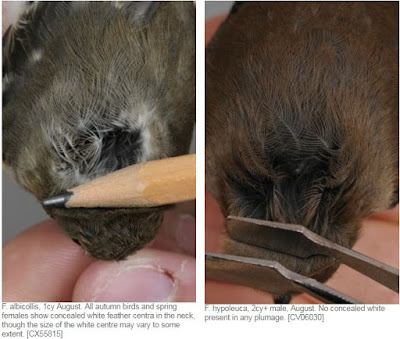From the outset a good arrival of Thrushes and Finches was obvious with 3 Song Thrushes, c.500 Redwing, c.50 Fieldfare, c.50 Blackbirds and c.100 Brambling and c.30 Chaffinches seen throughout the day. A Peregrine flew over Valyie and yesterday's first-winter Ficedula was still present as were 5 Blackcaps, 4 Chiffchaffs and 4 Goldcrests. A female Hawfinch appeared in our garden late morning. We enjoyed a coffee with Wilma seeing a Barred Warbler, a Chiffchaff and a Goldcrest in the process. An evening visit to Skaw produced a Mistle Thrush.
Raven & Peregrine over Valyie
Brambling at Valyie
Fieldfares over Valyie
First-winter male Ficedula sp. at Leawart
Brian, Geoff & Martin found this bird yesterday and immediately flagged-up its extensive white primary patch when drawing other observers' attention to it. Being viewed in the strong wind it was difficult to see much critical detail and the light was so poor it was impossible to obtain any useful images. It was performing much better today in the increasingly calm conditions. The tertial pattern and moult contrast in its greater coverts would appear to age it as a first-winter, and its inky-black longest uppertail-coverts sex it as a male. The identification of some first-winter Ficedula is incredibly difficult (impossible in the field?) compounded by the hybridization of Collared and Pied Flycatchers producing birds with intermediate appearance and further hindering the understanding of the complete variation of pure bred birds. Whilst the white primary patch protruding beyond its primary coverts (see Shirihai & Svensson 2018), almost ghosted collar (even the suggestion of concealed white feather centers in its nape) and the white on its outer tail feathers reaching the tips could be construed as pro-Collared features, but being a male, it might then be expected that its primary patch extends onto its outer primaries and I didn't get the impression of it showing much white in the tail. However, intriguingly, whilst it twice failed to show any response to two playbacks of the song of Pied Flycatcher, it twice responded vigorously to the playback of the song of Collared Flycatcher - on the second occasion immediately flying in from c.50m. Whilst I've personally no firm feelings as to its identity, I will find it one of the most thought-provoking birds of the Autumn.

More on the identification of Ficedula here from which I've copied the image below of a Collared Flycatcher trapped at Spurn 30th August 2010:

and here from which I've copied the image below:
Collared Flycatcher (left) and Pied Flycatcher (right) at Ottenby
Female Hawfinch at Norwick
Dunlin at Norwick
Barred Warbler at Norwick
Mistle Thrush at Skaw
































